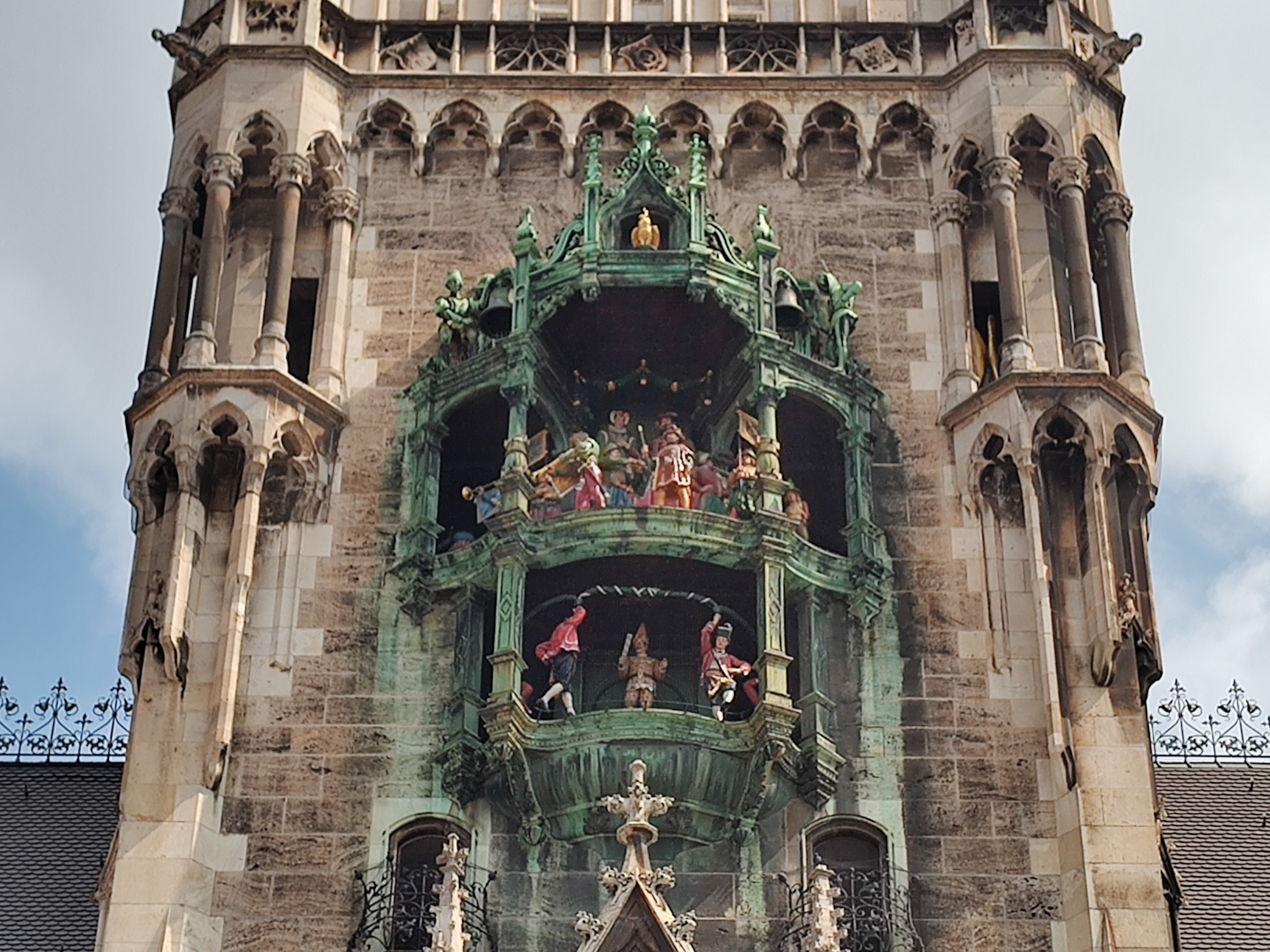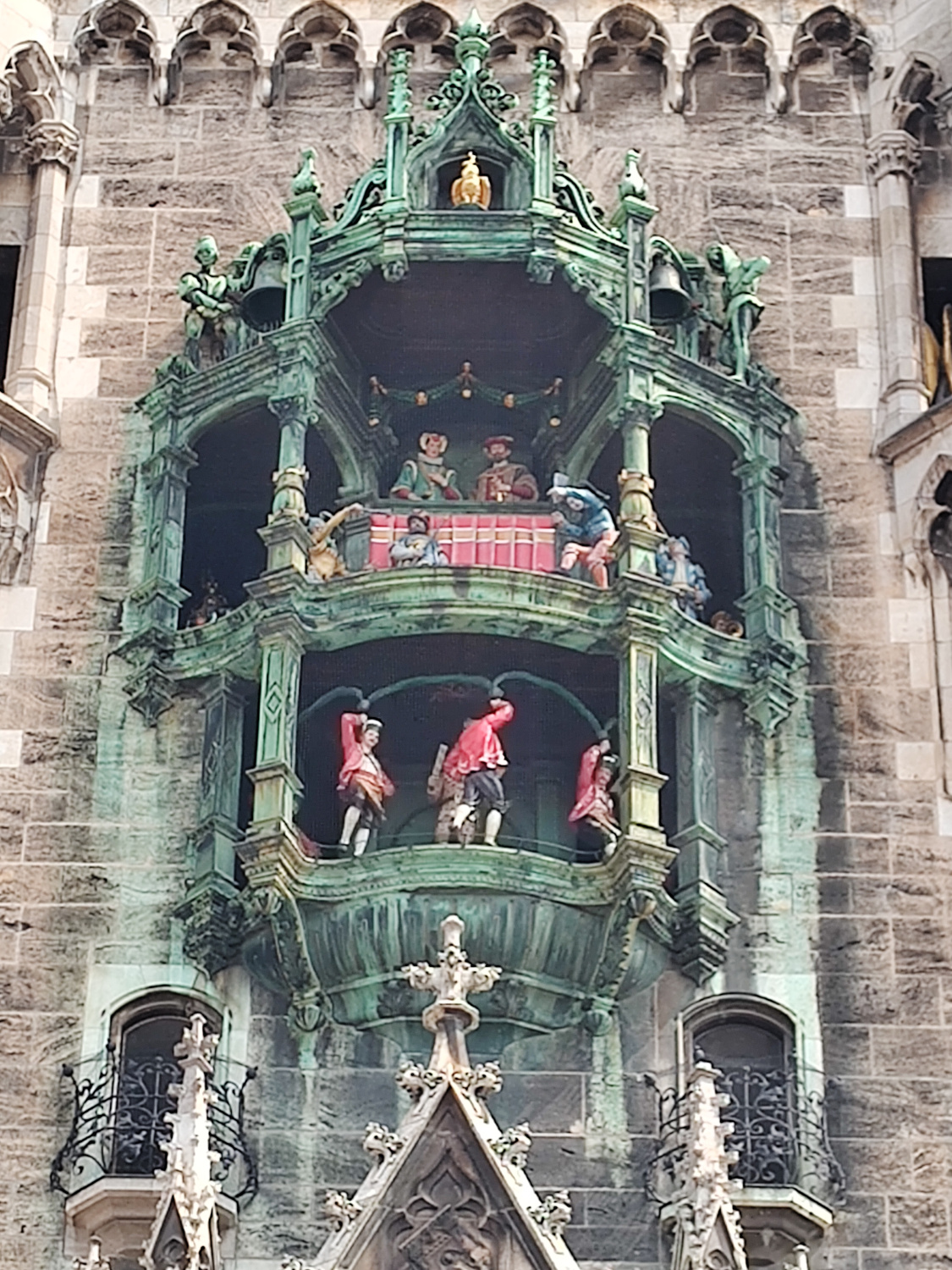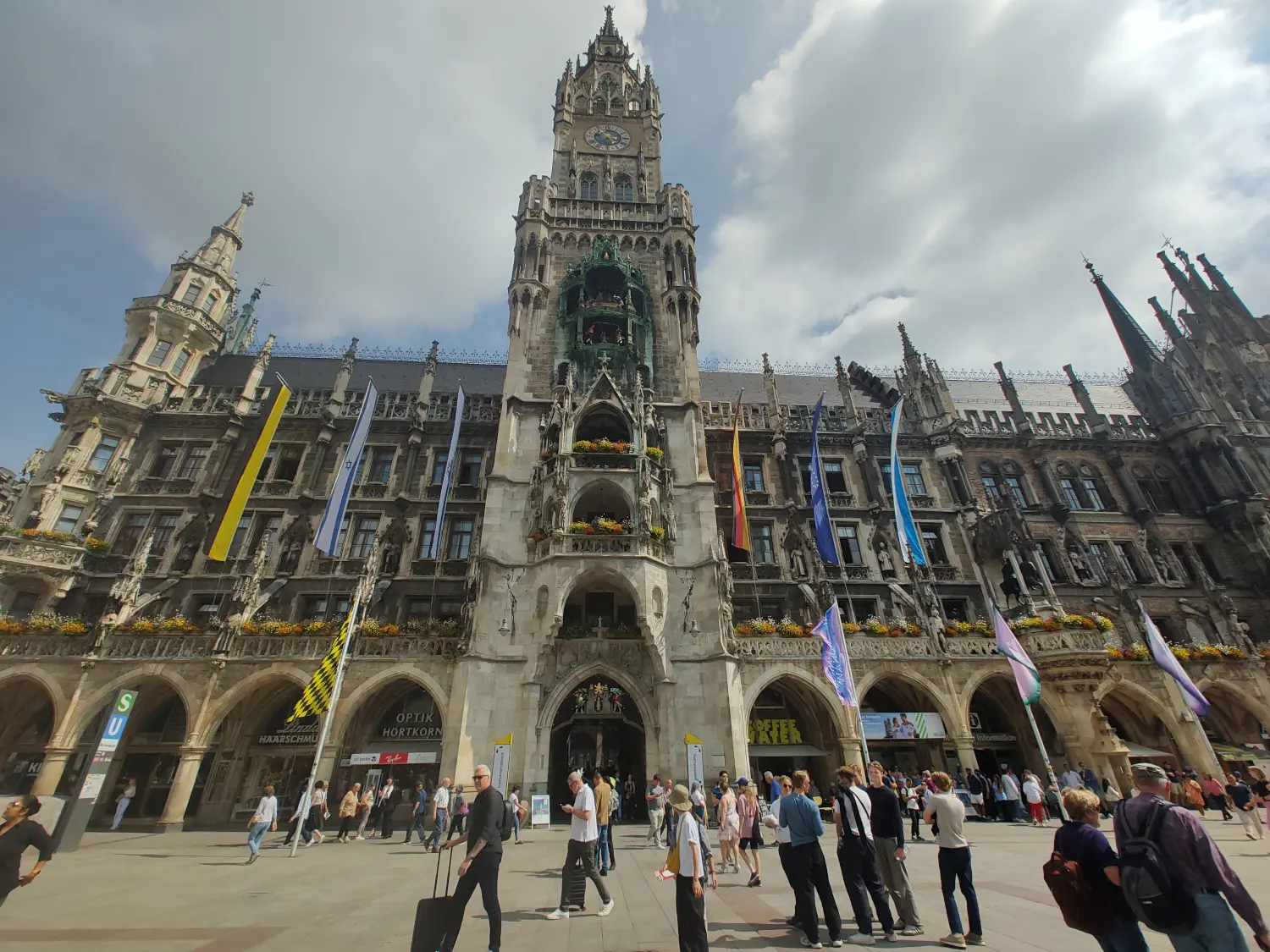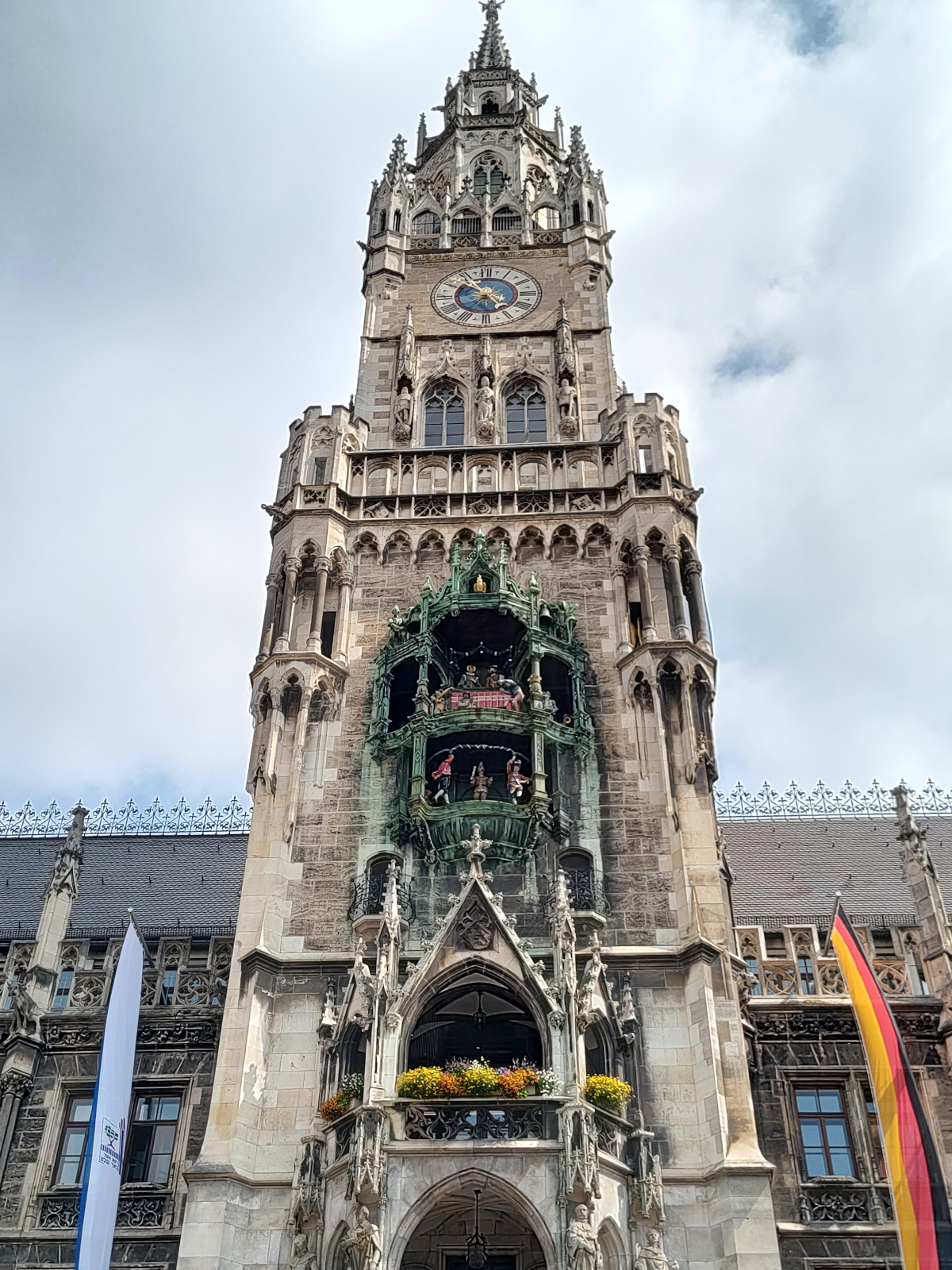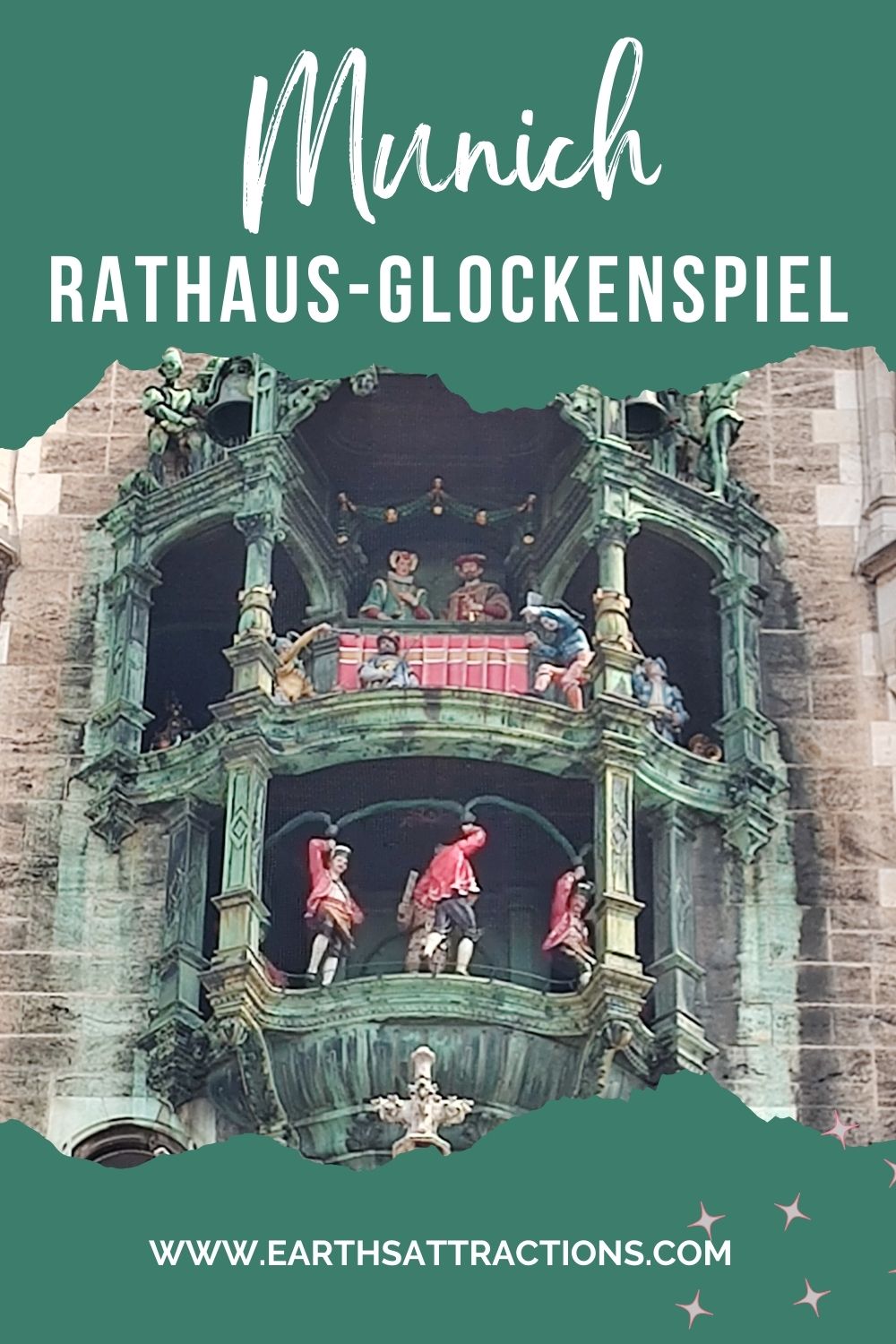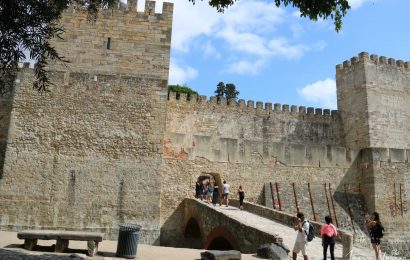The Rathaus-Glockenspiel is one of Munich’s most iconic landmarks. Located in Marienplatz, the heart of the city, this large mechanical clock is a must-see for anyone visiting Munich.
Of course, we did not miss it! I created the Munich itinerary, and this was on day one in the city. It was the FIRST ATTRACTION in Munich we visited. This iconic clock, adorning the New Town Hall (Neues Rathaus), has captivated visitors for over a century with its charming performances and intricate details. In this comprehensive guide, I’ll explore the fascinating world of the Glockenspiel, from its rich history to practical visiting tips, and why it’s a key part of Munich’s cultural heritage.
So what is the Rathaus-Glockenspiel in Munich? +
The History of the Rathaus-Glockenspiel
The Rathaus-Glockenspiel is a large mechanical clock located in the tower of the New Town Hall (Neues Rathaus) in Marienplatz, Munich’s central square. It was installed in 1908 and has since become one of the city’s most beloved attractions.
The Glockenspiel consists of 43 bells and 32 life-sized figurines that re-enact two significant historical events from Bavarian history. The performance, which takes place daily, lasts for about 12 to 15 minutes and features music, moving figures, and a jousting match.
The Glockenspiel is not just a tourist attraction; it’s a symbol of Bavarian pride and tradition, drawing locals and visitors alike.
The New Town Hall, where the Glockenspiel is located, was built between 1867 and 1908. Designed in a neo-Gothic style, the building itself is a masterpiece of architecture, but the Rathaus-Glockenspiel added a unique charm to the structure when it was completed in 1908. I will share more info about the New Town Hall – Neues Rathaus in Munchen – in a different article, including tips for visiting.
Getting back to the clock, this was designed to commemorate significant events in Bavarian history, and it continues to honor these traditions to this day.
Historical Events Re-Enacted by the Glockenspiel and How the Rathaus-Glockenspiel Works
The figures of the famous Munich clock at Marienplatz are arranged on two levels. The top-level features the jousting knights, while the bottom level is reserved for the Cooper’s Dance.
The Wedding of Duke Wilhelm V of Bavaria and Renata of Lorraine (1568):
The top half of the Glockenspiel re-enacts the lavish wedding celebration of Duke Wilhelm V of Bavaria and Renata of Lorraine, which took place in 1568.
The highlight of this celebration was a jousting tournament between knights from Bavaria and Lorraine, which is depicted by two mechanical knights charging at each other.
As the bells play, the knights tilt their lances toward each other in a mock joust, and the dancers twirl below.
One of the most exciting moments of the performance is when the Bavarian knight knocks the opponent from Lorraine off his horse—symbolizing Bavaria’s triumph in the 1568 jousting match.
After the performance, a golden rooster located at the top of the Glockenspiel crows three times, signaling the end of the show.
The Schäfflertanz (The Cooper’s Dance):
The bottom half of the Glockenspiel features the Schäfflertanz, a dance performed by the Coopers (barrel makers) in Munich.
This tradition dates back to 1517 when the plague ravaged Munich. According to legend, the Coopers danced in the streets to raise the spirits of the people and encourage them to return to normal life after the epidemic ended.
This dance is still performed in Munich every seven years as part of a local tradition.
When to See the Rathaus-Glockenspiel in Action
If you’re planning a visit to Munich, timing your trip to see the Rathaus-Glockenspiel in action is a must. The clock performs its daily show at the following times:
- 11:00 AM: Daily performance throughout the year.
- 12:00 PM: An additional performance from March to October.
- 5:00 PM: An evening performance from March to October.
If you visit Munich during the winter months, catch the 11:00 AM show, as this is the only daily performance in winter. No matter the time you choose, arrive a few minutes early to secure a good viewing spot in Marienplatz.
What performance we chose
We chose to be there around 10.40 – and it was a great choice. We were able to choose our places in the square – keep in mind that this is a huge attraction and many tourists come here to see the clock.
There were a few guided tours there, but there were also tourists visiting independently.
As you will see, you need to be a bit away from the facade – otherwise you will not see all the statues and the dances properly. It will be easy to figure out where to stay once you get there, trust me.
An interesting fact
The Munich clock is operated manually by people. It is not an automated mechanism. Everyday, several people make sure that people can enjoy the splendid show the clock offers.
How Long Does the Glockenspiel Performance Last?
The performance of the Rathaus-Glockenspiel lasts approximately 12 to 15 minutes. This gives you plenty of time to enjoy the show, take photos, and soak in the atmosphere of Marienplatz, one of Munich’s busiest and most beautiful squares.
During the performance, you’ll hear traditional Bavarian tunes played on the bells, which add to the magical feeling of the experience. The sound of the bells, combined with the life-sized figures moving in a rhythmic dance, is an unforgettable sight.
I admit we recorded the entire show and I was planning on posting it on YouTube and including it here. But I realize that our recording does not begin to reveal the wonderful show the clock in Marienplatz, Munich offers. So I am inviting you to not miss this when in the area!
Visiting the Rathaus-Glockenspiel: Practical Tips
The Best Viewing Spots for the Rathaus-Glockenspiel
While the Glockenspiel can be seen from anywhere in Marienplatz, the best views are from:
To get the best view of the Rathaus-Glockenspiel, as I already mentioned, it’s recommended to stand in the center of Marienplatz facing the New Town Hall.
The square tends to fill up quickly, especially during peak tourist seasons, so it’s a good idea to arrive at least 10-15 minutes before the performance begins.
If you’re looking for an even better vantage point, you can head to the Café Glockenspiel, which is located in a building opposite the New Town Hall. From here, you can enjoy a bird’s-eye view of the performance while sipping a coffee or enjoying a light meal.
Another option is the tower of St. Peter’s Church (Alter Peter) for a unique elevated view.
We chose to be in the square – though I’ve seen pictures online of the vire from the cafe and they were quite mesmerizing. So, depending on your budget and timeline, you could choose that cafe or the church as an observation point.
Accessibility: How to get to the Rathaus-Glockenspiel
Marienplatz is easily accessible by public transportation:
- U-Bahn: Lines U3 and U6, Marienplatz station
- S-Bahn: All lines stop at Marienplatz
We used the MVV app and got to Marienplatz with a combination of bus and U-Bahn.
As we climbed the stairs from U-Bahn we were welcomed by the impressive New Town Hall – it was quite a special view (again, for us it was the first attraction we visited in Munich.)
Nearby Attractions
Make the most of your visit by exploring these nearby attractions:
- Viktualienmarkt: A gourmet food market just a short walk from Marienplatz
- Frauenkirche: Munich’s iconic cathedral with its distinctive twin towers
- Hofbräuhaus: The world-famous beer hall, perfect for experiencing Bavarian culture
I will write detailed articles about them soon and I will link them here 🙂
Why the Rathaus-Glockenspiel is a Must-See in Munich
Whether you’re visiting Munich for a day or staying for a longer period, the Rathaus-Glockenspiel is one of the most memorable experiences you can have. It combines Bavarian history, tradition, and mechanical ingenuity in a way that captivates visitors of all ages.
The best part? It’s completely free to watch! You don’t need to buy a ticket or make a reservation—just show up at the right time, and you’ll be treated to one of Munich’s most iconic attractions.
Conclusion: A Timeless Symbol of Munich’s Charm
The Rathaus-Glockenspiel is more than just a clock; it’s a celebration of Bavarian culture and a piece of living history.
Its daily performances continue to enchant visitors from around the world, and every aspect of the performance tells a story. It’s a reminder of Munich’s deep-rooted traditions and a testament to the city’s ability to blend the past with the present.
Whether you’re interested in history or architecture, or just want to experience something truly unique, be sure to add the Rathaus-Glockenspiel to your list of things to see in Munich.


